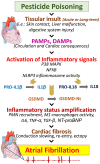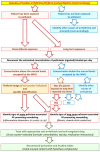Pollutants, including Organophosphorus and Organochloride Pesticides, May Increase the Risk of Cardiac Remodeling and Atrial Fibrillation: A Narrative Review
- PMID: 37760868
- PMCID: PMC10525278
- DOI: 10.3390/biomedicines11092427
Pollutants, including Organophosphorus and Organochloride Pesticides, May Increase the Risk of Cardiac Remodeling and Atrial Fibrillation: A Narrative Review
Abstract
Atrial fibrillation (AF) is the most common type of cardiac rhythm disorder. Recent clinical and experimental studies reveal that environmental pollutants, including organophosphorus-organochloride pesticides and air pollution, may contribute to the development of cardiac arrhythmias including AF. Here, we discussed the unifying cascade of events that may explain the role of pollutant exposure in the development of AF. Following ingestion and inhalation of pollution-promoting toxic compounds, damage-associated molecular pattern (DAMP) stimuli activate the inflammatory response and oxidative stress that may negatively affect the respiratory, cognitive, digestive, and cardiac systems. Although the detailed mechanisms underlying the association between pollutant exposure and the incidence of AF are not completely elucidated, some clinical reports and fundamental research data support the idea that pollutant poisoning can provoke perturbed ion channel function, myocardial electrical abnormalities, decreased action potential duration, slowed conduction, contractile dysfunction, cardiac fibrosis, and arrhythmias including AF.
Keywords: atrial fibrillation; cardiotoxicity; environmental pollution; pesticide.
Conflict of interest statement
The authors declare no conflict of interest.
Figures








Similar articles
-
Atrial fibrillation in horses part 1: Pathophysiology.Vet J. 2020 Sep;263:105521. doi: 10.1016/j.tvjl.2020.105521. Epub 2020 Jul 23. Vet J. 2020. PMID: 32928494
-
Electrical and contractile remodeling during the first days of atrial fibrillation go hand in hand.Circulation. 2003 Mar 18;107(10):1433-9. doi: 10.1161/01.cir.0000055314.10801.4f. Circulation. 2003. PMID: 12642366
-
The role of interleukins in pathogenesis and prognosis of atrial fibrillation.Expert Rev Clin Immunol. 2023 Jun;19(6):585-597. doi: 10.1080/1744666X.2023.2196013. Epub 2023 Mar 31. Expert Rev Clin Immunol. 2023. PMID: 36964672
-
A narrative review of non-coding RNAs in atrial fibrillation: potential therapeutic targets and molecular mechanisms.Ann Transl Med. 2021 Sep;9(18):1486. doi: 10.21037/atm-21-4483. Ann Transl Med. 2021. PMID: 34734038 Free PMC article. Review.
-
Electrical, contractile and structural remodeling during atrial fibrillation.Cardiovasc Res. 2002 May;54(2):230-46. doi: 10.1016/s0008-6363(02)00258-4. Cardiovasc Res. 2002. PMID: 12062329 Review.
Cited by
-
Investigate the binding of pesticides with the TLR4 receptor protein found in mammals and zebrafish using molecular docking and molecular dynamics simulations.Sci Rep. 2024 Oct 18;14(1):24504. doi: 10.1038/s41598-024-75527-6. Sci Rep. 2024. PMID: 39424974 Free PMC article.
-
Plasma-Treated Nanostructured Resistive Gas Sensors: A Review.Sensors (Basel). 2025 Apr 5;25(7):2307. doi: 10.3390/s25072307. Sensors (Basel). 2025. PMID: 40218819 Free PMC article. Review.
-
What is pesticide-induced epilepsy?Clinics (Sao Paulo). 2024 Nov 8;79:100515. doi: 10.1016/j.clinsp.2024.100515. eCollection 2024. Clinics (Sao Paulo). 2024. PMID: 39520799 Free PMC article. No abstract available.
References
Publication types
Grants and funding
LinkOut - more resources
Full Text Sources

